Jin Gao
Step-GUI Technical Report
Dec 19, 2025Abstract:Recent advances in multimodal large language models unlock unprecedented opportunities for GUI automation. However, a fundamental challenge remains: how to efficiently acquire high-quality training data while maintaining annotation reliability? We introduce a self-evolving training pipeline powered by the Calibrated Step Reward System, which converts model-generated trajectories into reliable training signals through trajectory-level calibration, achieving >90% annotation accuracy with 10-100x lower cost. Leveraging this pipeline, we introduce Step-GUI, a family of models (4B/8B) that achieves state-of-the-art GUI performance (8B: 80.2% AndroidWorld, 48.5% OSWorld, 62.6% ScreenShot-Pro) while maintaining robust general capabilities. As GUI agent capabilities improve, practical deployment demands standardized interfaces across heterogeneous devices while protecting user privacy. To this end, we propose GUI-MCP, the first Model Context Protocol for GUI automation with hierarchical architecture that combines low-level atomic operations and high-level task delegation to local specialist models, enabling high-privacy execution where sensitive data stays on-device. Finally, to assess whether agents can handle authentic everyday usage, we introduce AndroidDaily, a benchmark grounded in real-world mobile usage patterns with 3146 static actions and 235 end-to-end tasks across high-frequency daily scenarios (8B: static 89.91%, end-to-end 52.50%). Our work advances the development of practical GUI agents and demonstrates strong potential for real-world deployment in everyday digital interactions.
Online Segment Any 3D Thing as Instance Tracking
Dec 08, 2025Abstract:Online, real-time, and fine-grained 3D segmentation constitutes a fundamental capability for embodied intelligent agents to perceive and comprehend their operational environments. Recent advancements employ predefined object queries to aggregate semantic information from Vision Foundation Models (VFMs) outputs that are lifted into 3D point clouds, facilitating spatial information propagation through inter-query interactions. Nevertheless, perception is an inherently dynamic process, rendering temporal understanding a critical yet overlooked dimension within these prevailing query-based pipelines. Therefore, to further unlock the temporal environmental perception capabilities of embodied agents, our work reconceptualizes online 3D segmentation as an instance tracking problem (AutoSeg3D). Our core strategy involves utilizing object queries for temporal information propagation, where long-term instance association promotes the coherence of features and object identities, while short-term instance update enriches instant observations. Given that viewpoint variations in embodied robotics often lead to partial object visibility across frames, this mechanism aids the model in developing a holistic object understanding beyond incomplete instantaneous views. Furthermore, we introduce spatial consistency learning to mitigate the fragmentation problem inherent in VFMs, yielding more comprehensive instance information for enhancing the efficacy of both long-term and short-term temporal learning. The temporal information exchange and consistency learning facilitated by these sparse object queries not only enhance spatial comprehension but also circumvent the computational burden associated with dense temporal point cloud interactions. Our method establishes a new state-of-the-art, surpassing ESAM by 2.8 AP on ScanNet200 and delivering consistent gains on ScanNet, SceneNN, and 3RScan datasets.
PFSD: A Multi-Modal Pedestrian-Focus Scene Dataset for Rich Tasks in Semi-Structured Environments
Feb 24, 2025Abstract:Recent advancements in autonomous driving perception have revealed exceptional capabilities within structured environments dominated by vehicular traffic. However, current perception models exhibit significant limitations in semi-structured environments, where dynamic pedestrians with more diverse irregular movement and occlusion prevail. We attribute this shortcoming to the scarcity of high-quality datasets in semi-structured scenes, particularly concerning pedestrian perception and prediction. In this work, we present the multi-modal Pedestrian-Focused Scene Dataset(PFSD), rigorously annotated in semi-structured scenes with the format of nuScenes. PFSD provides comprehensive multi-modal data annotations with point cloud segmentation, detection, and object IDs for tracking. It encompasses over 130,000 pedestrian instances captured across various scenarios with varying densities, movement patterns, and occlusions. Furthermore, to demonstrate the importance of addressing the challenges posed by more diverse and complex semi-structured environments, we propose a novel Hybrid Multi-Scale Fusion Network (HMFN). Specifically, to detect pedestrians in densely populated and occluded scenarios, our method effectively captures and fuses multi-scale features using a meticulously designed hybrid framework that integrates sparse and vanilla convolutions. Extensive experiments on PFSD demonstrate that HMFN attains improvement in mean Average Precision (mAP) over existing methods, thereby underscoring its efficacy in addressing the challenges of 3D pedestrian detection in complex semi-structured environments. Coding and benchmark are available.
MedForge: Building Medical Foundation Models Like Open Source Software Development
Feb 22, 2025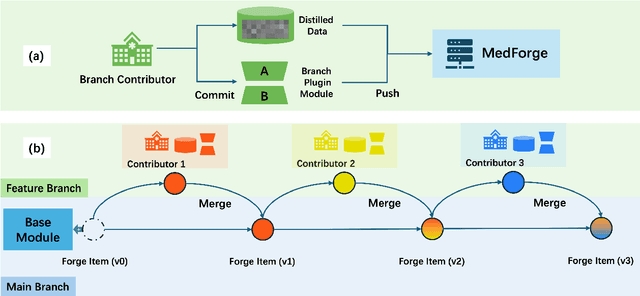

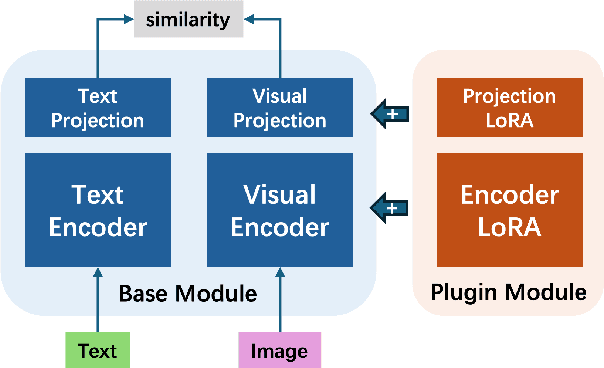

Abstract:Foundational models (FMs) have made significant strides in the healthcare domain. Yet the data silo challenge and privacy concern remain in healthcare systems, hindering safe medical data sharing and collaborative model development among institutions. The collection and curation of scalable clinical datasets increasingly become the bottleneck for training strong FMs. In this study, we propose Medical Foundation Models Merging (MedForge), a cooperative framework enabling a community-driven medical foundation model development, meanwhile preventing the information leakage of raw patient data and mitigating synchronization model development issues across clinical institutions. MedForge offers a bottom-up model construction mechanism by flexibly merging task-specific Low-Rank Adaptation (LoRA) modules, which can adapt to downstream tasks while retaining original model parameters. Through an asynchronous LoRA module integration scheme, the resulting composite model can progressively enhance its comprehensive performance on various clinical tasks. MedForge shows strong performance on multiple clinical datasets (e.g., breast cancer, lung cancer, and colon cancer) collected from different institutions. Our major findings highlight the value of collaborative foundation models in advancing multi-center clinical collaboration effectively and cohesively. Our code is publicly available at https://github.com/TanZheling/MedForge.
HSTrack: Bootstrap End-to-End Multi-Camera 3D Multi-object Tracking with Hybrid Supervision
Nov 11, 2024



Abstract:In camera-based 3D multi-object tracking (MOT), the prevailing methods follow the tracking-by-query-propagation paradigm, which employs track queries to manage the lifecycle of identity-consistent tracklets while object queries handle the detection of new-born tracklets. However, this intertwined paradigm leads the inter-temporal tracking task and the single-frame detection task utilize the same model parameters, complicating training optimization. Drawing inspiration from studies on the roles of attention components in transformer-based decoders, we identify that the dispersing effect of self-attention necessitates object queries to match with new-born tracklets. This matching strategy diverges from the detection pre-training phase, where object queries align with all ground-truth targets, resulting in insufficient supervision signals. To address these issues, we present HSTrack, a novel plug-and-play method designed to co-facilitate multi-task learning for detection and tracking. HSTrack constructs a parallel weight-share decoder devoid of self-attention layers, circumventing competition between different types of queries. Considering the characteristics of cross-attention layer and distinct query types, our parallel decoder adopt one-to-one and one-to-many label assignment strategies for track queries and object queries, respectively. Leveraging the shared architecture, HSTrack further improve trackers for spatio-temporal modeling and quality candidates generation. Extensive experiments demonstrate that HSTrack consistently delivers improvements when integrated with various query-based 3D MOT trackers. For example, HSTrack improves the state-of-the-art PF-Track method by $+2.3\%$ AMOTA and $+1.7\%$ mAP on the nuScenes dataset.
VQ-Map: Bird's-Eye-View Map Layout Estimation in Tokenized Discrete Space via Vector Quantization
Nov 03, 2024



Abstract:Bird's-eye-view (BEV) map layout estimation requires an accurate and full understanding of the semantics for the environmental elements around the ego car to make the results coherent and realistic. Due to the challenges posed by occlusion, unfavourable imaging conditions and low resolution, \emph{generating} the BEV semantic maps corresponding to corrupted or invalid areas in the perspective view (PV) is appealing very recently. \emph{The question is how to align the PV features with the generative models to facilitate the map estimation}. In this paper, we propose to utilize a generative model similar to the Vector Quantized-Variational AutoEncoder (VQ-VAE) to acquire prior knowledge for the high-level BEV semantics in the tokenized discrete space. Thanks to the obtained BEV tokens accompanied with a codebook embedding encapsulating the semantics for different BEV elements in the groundtruth maps, we are able to directly align the sparse backbone image features with the obtained BEV tokens from the discrete representation learning based on a specialized token decoder module, and finally generate high-quality BEV maps with the BEV codebook embedding serving as a bridge between PV and BEV. We evaluate the BEV map layout estimation performance of our model, termed VQ-Map, on both the nuScenes and Argoverse benchmarks, achieving 62.2/47.6 mean IoU for surround-view/monocular evaluation on nuScenes, as well as 73.4 IoU for monocular evaluation on Argoverse, which all set a new record for this map layout estimation task. The code and models are available on \url{https://github.com/Z1zyw/VQ-Map}.
Dissecting Dissonance: Benchmarking Large Multimodal Models Against Self-Contradictory Instructions
Aug 05, 2024

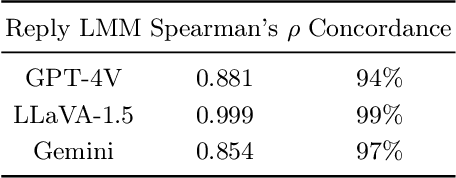

Abstract:Large multimodal models (LMMs) excel in adhering to human instructions. However, self-contradictory instructions may arise due to the increasing trend of multimodal interaction and context length, which is challenging for language beginners and vulnerable populations. We introduce the Self-Contradictory Instructions benchmark to evaluate the capability of LMMs in recognizing conflicting commands. It comprises 20,000 conflicts, evenly distributed between language and vision paradigms. It is constructed by a novel automatic dataset creation framework, which expedites the process and enables us to encompass a wide range of instruction forms. Our comprehensive evaluation reveals current LMMs consistently struggle to identify multimodal instruction discordance due to a lack of self-awareness. Hence, we propose the Cognitive Awakening Prompting to inject cognition from external, largely enhancing dissonance detection. The dataset and code are here: https://selfcontradiction.github.io/.
Temporal Correlation Meets Embedding: Towards a 2nd Generation of JDE-based Real-Time Multi-Object Tracking
Jul 19, 2024



Abstract:Joint Detection and Embedding(JDE) trackers have demonstrated excellent performance in Multi-Object Tracking(MOT) tasks by incorporating the extraction of appearance features as auxiliary tasks through embedding Re-Identification task(ReID) into the detector, achieving a balance between inference speed and tracking performance. However, solving the competition between the detector and the feature extractor has always been a challenge. Also, the issue of directly embedding the ReID task into MOT has remained unresolved. The lack of high discriminability in appearance features results in their limited utility. In this paper, we propose a new learning approach using cross-correlation to capture temporal information of objects. The feature extraction network is no longer trained solely on appearance features from each frame but learns richer motion features by utilizing feature heatmaps from consecutive frames, addressing the challenge of inter-class feature similarity. Furthermore, we apply our learning approach to a more lightweight feature extraction network, and treat the feature matching scores as strong cues rather than auxiliary cues, employing a appropriate weight calculation to reflect the compatibility between our obtained features and the MOT task. Our tracker, named TCBTrack, achieves state-of-the-art performance on multiple public benchmarks, i.e., MOT17, MOT20, and DanceTrack datasets. Specifically, on the DanceTrack test set, we achieve 56.8 HOTA, 58.1 IDF1 and 92.5 MOTA, making it the best online tracker that can achieve real-time performance. Comparative evaluations with other trackers prove that our tracker achieves the best balance between speed, robustness and accuracy.
Animate3D: Animating Any 3D Model with Multi-view Video Diffusion
Jul 16, 2024
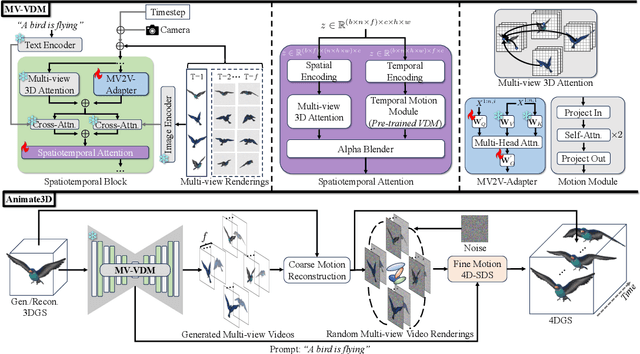

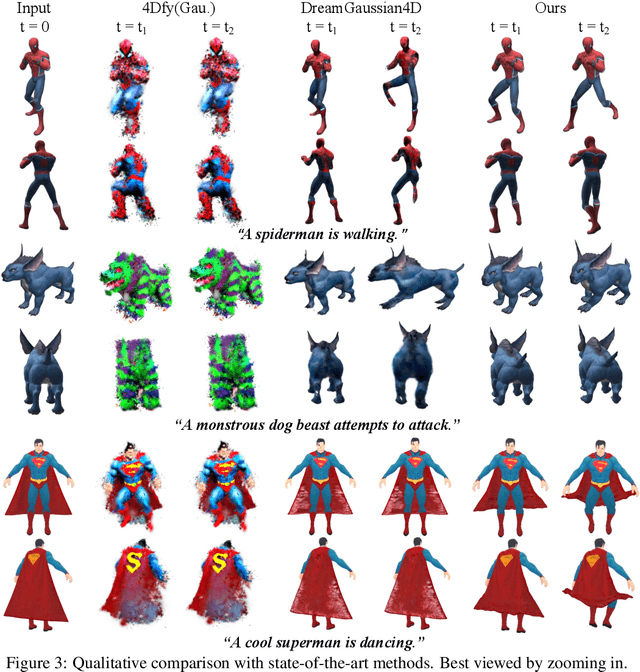
Abstract:Recent advances in 4D generation mainly focus on generating 4D content by distilling pre-trained text or single-view image-conditioned models. It is inconvenient for them to take advantage of various off-the-shelf 3D assets with multi-view attributes, and their results suffer from spatiotemporal inconsistency owing to the inherent ambiguity in the supervision signals. In this work, we present Animate3D, a novel framework for animating any static 3D model. The core idea is two-fold: 1) We propose a novel multi-view video diffusion model (MV-VDM) conditioned on multi-view renderings of the static 3D object, which is trained on our presented large-scale multi-view video dataset (MV-Video). 2) Based on MV-VDM, we introduce a framework combining reconstruction and 4D Score Distillation Sampling (4D-SDS) to leverage the multi-view video diffusion priors for animating 3D objects. Specifically, for MV-VDM, we design a new spatiotemporal attention module to enhance spatial and temporal consistency by integrating 3D and video diffusion models. Additionally, we leverage the static 3D model's multi-view renderings as conditions to preserve its identity. For animating 3D models, an effective two-stage pipeline is proposed: we first reconstruct motions directly from generated multi-view videos, followed by the introduced 4D-SDS to refine both appearance and motion. Qualitative and quantitative experiments demonstrate that Animate3D significantly outperforms previous approaches. Data, code, and models will be open-released.
Graspness Discovery in Clutters for Fast and Accurate Grasp Detection
Jun 17, 2024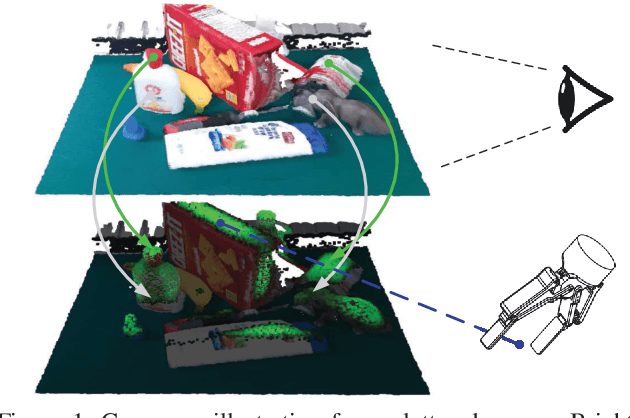

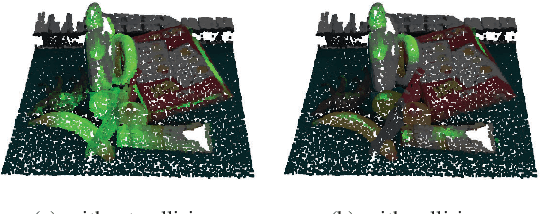

Abstract:Efficient and robust grasp pose detection is vital for robotic manipulation. For general 6 DoF grasping, conventional methods treat all points in a scene equally and usually adopt uniform sampling to select grasp candidates. However, we discover that ignoring where to grasp greatly harms the speed and accuracy of current grasp pose detection methods. In this paper, we propose "graspness", a quality based on geometry cues that distinguishes graspable areas in cluttered scenes. A look-ahead searching method is proposed for measuring the graspness and statistical results justify the rationality of our method. To quickly detect graspness in practice, we develop a neural network named cascaded graspness model to approximate the searching process. Extensive experiments verify the stability, generality and effectiveness of our graspness model, allowing it to be used as a plug-and-play module for different methods. A large improvement in accuracy is witnessed for various previous methods after equipping our graspness model. Moreover, we develop GSNet, an end-to-end network that incorporates our graspness model for early filtering of low-quality predictions. Experiments on a large-scale benchmark, GraspNet-1Billion, show that our method outperforms previous arts by a large margin (30+ AP) and achieves a high inference speed. The library of GSNet has been integrated into AnyGrasp, which is at https://github.com/graspnet/anygrasp_sdk.
 Add to Chrome
Add to Chrome Add to Firefox
Add to Firefox Add to Edge
Add to Edge